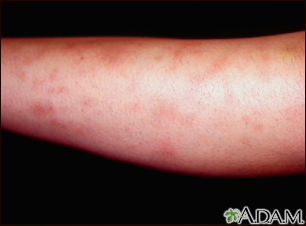A phase 1b/2 study of XTMAB-16 in patients with pulmonary sarcoidosis
- Status
- Accepting Candidates
- Ages
- 18 Years - 80 Years
- Sexes
- All
Update your location to show providers, locations, and services closest to you.
Sarcoidosis is a disease in which inflammation occurs in the lymph nodes, lungs, liver, eyes, skin, and/or other tissues.
The exact cause of sarcoidosis is unknown. What is known is that when a person has the disease, tiny clumps of abnormal tissue (granulomas) form in certain organs of the body. Granulomas are clusters of immune cells.
The disease can affect almost any organ. It most commonly affects the lungs.
Doctors think that having certain genes makes it more likely for a person to develop sarcoidosis. Things that may trigger the disease include infections with bacteria or viruses. Contact with dust or chemicals may also be triggers.
The disease is more common in African Americans and white people of Scandinavian heritage. More women than men have the disease.
The disease often begins between ages 20 and 40. Sarcoidosis is rare in young children.
A person with a close blood relative who has sarcoidosis is nearly 5 times as likely to develop the condition.
There may be no symptoms. When symptoms do occur, they can involve almost any body part or organ system.
Almost all people affected by sarcoidosis have lung or chest symptoms:
Symptoms of general discomfort may include:
Skin symptoms may include:
Nervous system symptoms may include:
Eye symptoms may include:
Other symptoms of this disease may include:
The health care provider will perform a physical examination and ask about the symptoms.
Different imaging tests may help diagnose sarcoidosis:
To diagnose this condition, a biopsy is needed. Biopsy of the lung using bronchoscopy is usually done. Biopsies of other body tissues may also be done.
The following lab tests may be done:
Sarcoidosis symptoms will often get better without treatment.
If the eyes, heart, nervous system, or lungs are affected, corticosteroids are usually prescribed. This medicine may need to be taken for 1 to 2 years.
Medicines that suppress the immune system are sometimes also needed.
In rare cases, people with very severe heart or lung damage (end-stage disease) may need an organ transplant.
With sarcoidosis that affects the heart, an implantable cardioverter-defibrillator (ICD) may be needed to treat heart rhythm problems.
Many people with sarcoidosis are not seriously ill, and get better without treatment. Up to half of all people with the disease get better in 3 years without treatment. People whose lungs are affected may develop lung damage.
Overall death rate from sarcoidosis is less than 5%. Causes of death include:
Sarcoidosis may lead to these health problems:
Call your provider promptly if you have:









Iannuzzi MC. Sarcoidosis. Goldman L, Schafer AI, eds. Goldman-Cecil Medicine. 26th ed. Philadelphia, PA: Elsevier; 2020:chap 89.
Judson MA, Koth LL, Baughman RP. Sarcoidosis. In: Broaddus VC, Ernst JD, King TE, et al, eds. Murray and Nadel's Textbook of Respiratory Medicine. 7th ed. Philadelphia, PA: Elsevier; 2022:chap 93.
Soto-Gomez N, Peters JI, Nambiar AM. Diagnosis and management of sarcoidosis. Am Fam Physician. 2016;93(10):840-848. PMID: 27175719 pubmed.ncbi.nlm.nih.gov/27175719/.





UF Health research scientists make medicine better every day. They discover new ways to help people by running clinical trials. When you join a clinical trial, you can get advanced medical care. Sometimes years before it's available everywhere. You can also help make medicine better for everyone else. If you'd like to learn more about clinical trials, visit our clinical trials page. Or click one of the links below:
A phase 1b/2 study of XTMAB-16 in patients with pulmonary sarcoidosis
This study aims to evaluate the efficacy and safety of inhaled treprostinil in subjects with sarcoidosis-associated interstitial lung disease and pulmonary hypertension.
Annette Powell had always been an athlete. She was a collegiate basketball player with no prior health concerns. So in 2007, at age 43, this Ocala high school…
